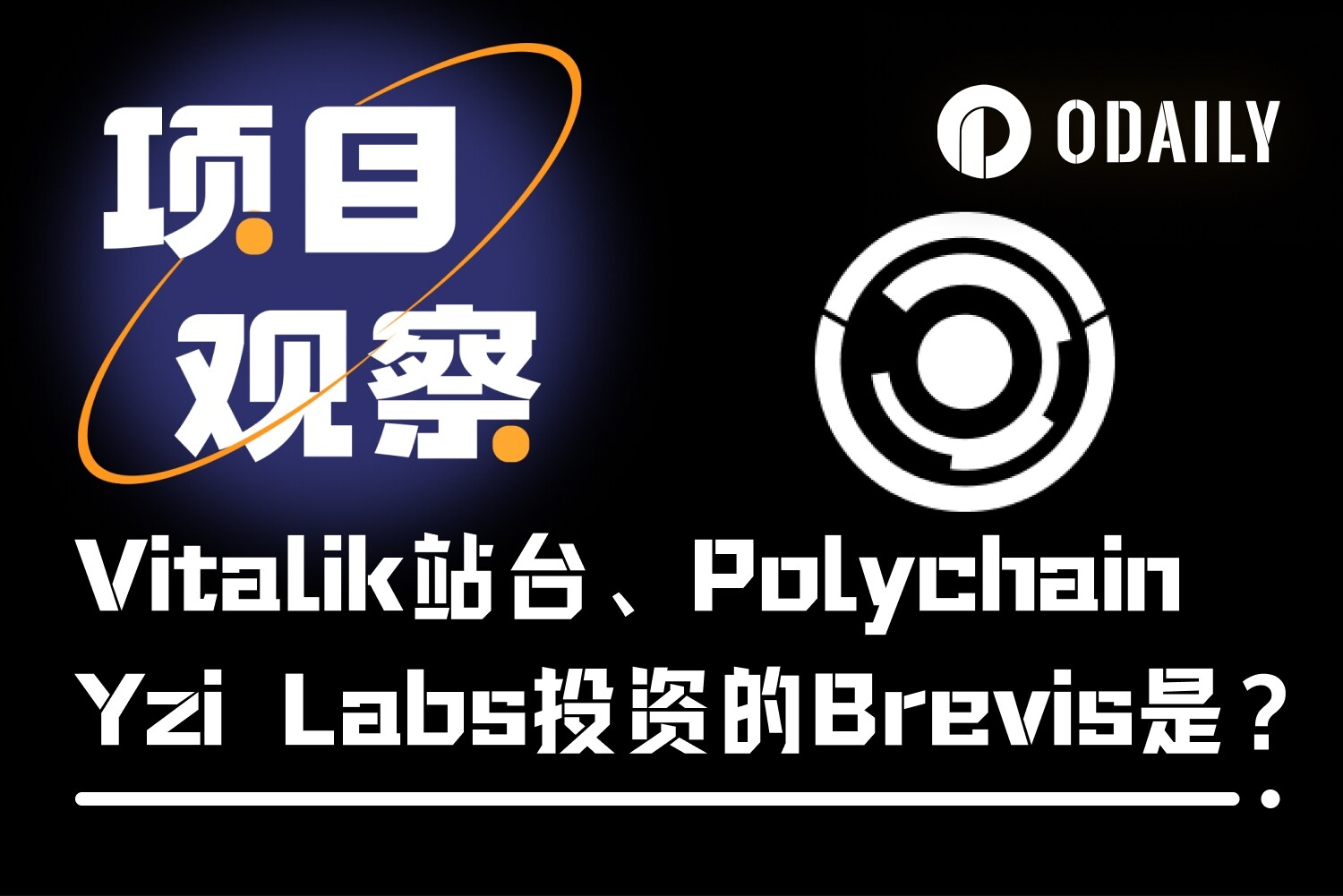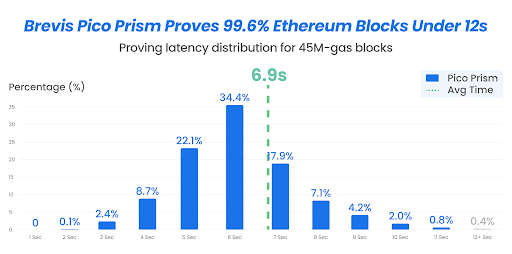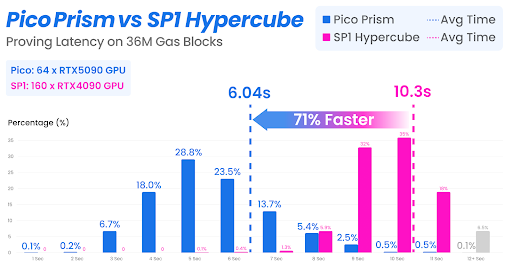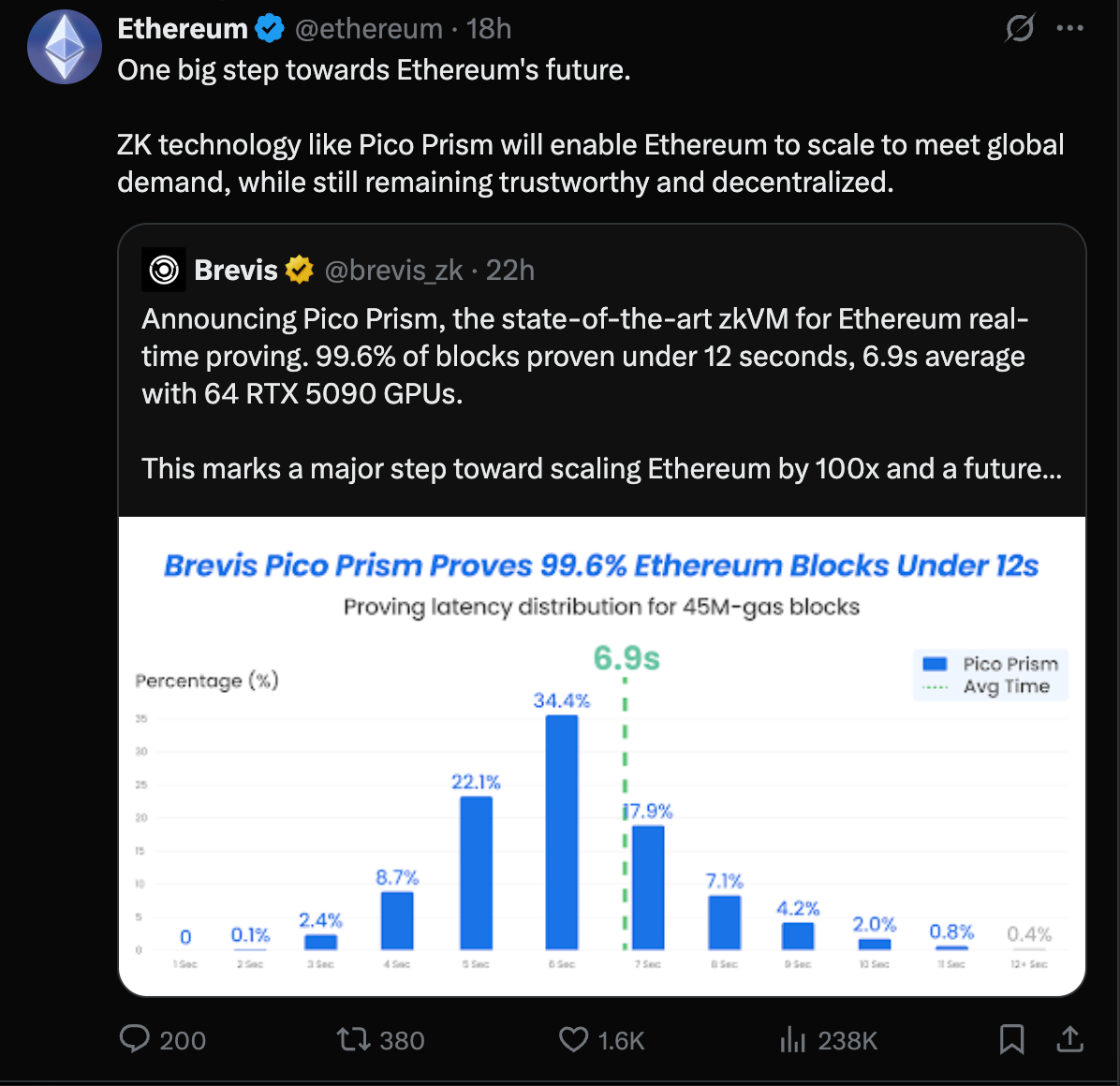Original|Odaily Planet Daily (@OdailyChina)

On October 15, Vitalik, who had not been seen for a long time, published a new article. This time, he did not share philosophical thoughts as before, but instead supported a project in his favorite ZK track—ZK computing layer Brevis. The project completed a $7.5 million seed round financing last November, led by Polychain and Yzi Labs (formerly Binance Labs); it had previously opened a Kaito ranking and points program. Odaily Planet Daily will briefly outline and analyze the specific situation of this project for readers' reference.
Brevis Pico Prism: The Greatest Hope for Ethereum Scalability x100?
On October 15, Brevis officially announced the latest progress of the project—launching the state-of-the-art zkVM Pico Prism for real-time proof on Ethereum.
According to the official introduction: “With a cluster equipped with 64 high-end RTX 5090 GPUs, 99.6% of ZK proof tasks can be completed within 12 seconds, averaging only 6.9 seconds.” In the future, “(users can even) verify the blockchain network through their mobile phones.”

This description may still not be direct enough, so let’s explain the following three questions step by step: What is Brevis? What is it used for? Why did it receive Vitalik's support?
Brevis: A "ZK Coprocessor" Focusing on the Concept of "Infinite Computing Layer"
According to official information, Brevis is a ZK coprocessor network built on zero-knowledge proofs, positioned as the "infinite computing layer for Web 3 and everything."
In March 2023, Celer announced the launch of the ZK full-chain data computing and verification platform Brevis. At that time, Brevis could help dApps access, compute, and utilize any data across multiple blockchains in a completely trustless manner, serving various tracks including data-driven DeFi, zkBridge, on-chain user acquisition, zkDID, and social account abstraction.
In April 2024, Brevis coChain AVS launched its mainnet. By combining ZK proofs with cryptoeconomic security driven by EigenLayer restaking, coChain aims to significantly reduce costs in ZK coprocessing and achieve new functionalities.
In February 2025, Brevis announced the launch of high-performance modular general zkVM (zero-knowledge virtual machine) Pico. Pico allows developers to use Rust language to connect highly optimized ZK coprocessors based on general zkVM. Developers can choose from a wide range of built-in options or fully customize the proof backend and virtual machine instances to optimize application performance and user experience.
In November 2024, after completing a $7.5 million financing round led by Polychain Capital and Binance Labs (now renamed Yzi Labs), with participation from IOSG Ventures, Nomad Capital, Bankless Ventures, Hashkey, and several undisclosed angel investors, Brevis officially announced its seed round financing. Additionally, co-founder Michael Dong Dong revealed that this round of financing was for token financing, but the specific valuation was not disclosed.
At that time, Brevis's ZK coprocessor was still in the testing mainnet phase, with partners including Kwenta, JoJo Exchange, Trusta, etc.; DeFi protocols such as PancakeSwap, Frax, Gamma, Quickswap, Mask Network, 0G, Bedrock, and Mellow Finance were all building products and features powered by Brevis.
The Value of Brevis: Serving On-chain and Off-chain Computing, Enhancing System Throughput
As for the value of Brevis, in short, it can help developers run complex computations off-chain (such as data processing, machine learning inference, simulations, etc.) and generate small ZK proofs to quickly verify results on-chain, thus enabling trustless scalable applications.
In simpler terms, it finds a balance between traditional on-chain computing (which is secure but has limited computing power, e.g., unable to efficiently process historical data) and powerful but unverifiable off-chain computing (which relies on centralized nodes)—achieving off-chain computation data through ZK technology and on-chain verification of results.
More specifically, the functions of Brevis as a "smart coprocessor" include:
- Accessing On-chain Historical Data: The ZK Data Coprocessor can query and compute any on-chain history (such as transaction volume, user behavior) and generate ZK proofs.
- Running Computations: Pico zkVM supports writing general programs in Rust, supporting ZKML (zero-knowledge machine learning), cross-chain verification, etc.
- Practical Applications: Enabling DeFi dynamic incentives, RWA transparent rewards, perp DEX loyalty programs, etc.
In simple terms, it allows smart contracts to be "smarter," shifting from passive execution to active computation, saving computing costs, improving computing efficiency, and facilitating user interaction with protocols, asset accumulation, and increasing protocol adoption.
Reasons for Vitalik's Support for Brevis: The Allure of ZK
As for the reasons why Brevis received Vitalik's support and praise, there are mainly three:
1. The effectiveness of Brevis's technical solution: It is 3.4 times faster than traditional methods, with hardware costs halved, directly addressing the redundant computation problem of Ethereum node validators and effectively reducing the overall workload.
2. The technical solution's high compatibility with the Ethereum ecosystem and roadmap: As a ZK coprocessor network, Brevis allows dApps to access historical on-chain data, run off-chain computations, and generate verifiable proofs, perfectly aligning with Vitalik's proposed Ethereum roadmap for 2025—which includes 99% coverage, sub-10 second proofs, hardware costs below $100,000, and home-level setups (10 kW power consumption). This will support higher gas limits, lower transaction fees, and more complex DeFi operations (such as dynamic fees for PancakeSwap, RWA rewards for Usual), enabling more people to participate in network validation via mobile phones, promoting L1 ZK-EVM integration and decentralization.
3. Overall ecological impact and actual adoption: Brevis has generated over 72.9 million proofs, covering 100 partners including MetaMask, PancakeSwap, and Frax, driving a $4 billion increase in TVL. It can be said that the emergence and development of Brevis is a genuine large-scale adoption solution.

Brevis Interaction Options: Development, Community Tasks
Currently, community users can interact by developing applications or participating in community tasks without needing professional ZK knowledge—
Developers:
SDK and Pico zkVM: Write code in Rust + a Solidity callback to build ZK applications (such as dynamic incentives, cross-chain security). Integration only requires three steps: specify data, run computation, on-chain verification. Documentation: https://docs.brevis.network/.
Example: Trade on PancakeSwap Infinity to earn LP rewards; verify restaking in Kernel DAO; participate in continuous incentives (CPI) in Usual Protocol.
Community Tasks:
Proving Grounds Event: Visit https://proving-grounds.brevis.network/, connect your wallet (follow @brevis_zk, join Discord).
Phase 1: Basic Training (2025.10.13 - 11.2): Social tasks, such as daily check-ins (10 Sparks/day, continuous check-in bonus up to 200), liking/sharing posts (100 Sparks + milestone bonus up to 500), inviting friends (200 Sparks/person).
Phase 2: Field Operations (starting November 3): On-chain interaction with real dApps (such as DEX trading, lending), earning more Sparks points.
Note: 1 wallet corresponds to 1 X account, Discord account, points update within 24 hours.
Finally, based on previous publications from the Ethereum Foundation, Brevis has a promising future.

免责声明:本文章仅代表作者个人观点,不代表本平台的立场和观点。本文章仅供信息分享,不构成对任何人的任何投资建议。用户与作者之间的任何争议,与本平台无关。如网页中刊载的文章或图片涉及侵权,请提供相关的权利证明和身份证明发送邮件到support@aicoin.com,本平台相关工作人员将会进行核查。



